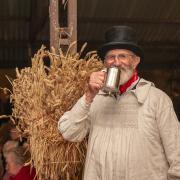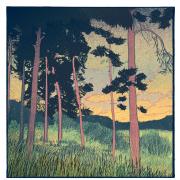For centuries, craftspeople have been revered and valued, and craftwork has been acknowledged as an essential part of human development. So when did ‘craft’ become a dirty word that’s only just being reclaimed? Katie Jarvis speaks to Charlotte Abrahams and Katy Bevan
‘Whoever wants to be a good philosopher ought to know how to mend his shoes too.’
Rudolf Steiner, Handwork Indications, quoted in Intelligent Hands (why making is a skill for life), by Charlotte Abrahams and Katy Bevan
Let’s take a seemingly random selection of people.


There’s Horace Lindezey, one of six siblings, who used to sit – mesmerised – watching his mum sewing beads onto beautiful bridesmaids dresses she would make at home. As a little lad, he was kept well away from these intricate creations; yet his mum’s work seeped in in other ways. Through Horace’s eyes and ears; through memory; until it emerged in his own hands. Today, he is known as a skilled illustrator, textile artist, sculptor and ceramicist, whose work (such as an intricate, ceramic ‘wedding cake’ for Kylie and Jason; or his unique and personal take on blue plaques) is funny, beautiful, clever.
Or Lasmin Salmon, whose sculptural textiles challenge the spectrum to find more colours than its current meagre offerings. Bursting with reds, golds, greens, polka dots, fluff, silk, felt, they defy you not to follow your eyes by reaching out to feast on touch.

Zoe Collis who thrived in class but hated exams. She loved art, but her parents – concerned for her future – thought maths and science were far better options. After all, university was surely a path to success. Yet now – still in her 20s with an apprenticeship behind her – Zoe hand-makes paper of the finest quality, valued by artists and designers. Often steeped up to her elbows in cotton (the material with which she works, along with linen), she proudly uses techniques perfected over thousands of years.
Or Sam, who volunteers at Nailsworth Community Workshop on the Pi Guitars project: making the finest-quality instruments out of recycled wood.
(And I could offer you so many more.)
Some connections are clear. All are artists; craftspeople who work with their hands to produce beautiful, desirable and high-value (expensive, if you like) objects.
But there’s more.
Each has a very specific relationship with their craft.
Horace and Lasmin both have learning disabilities. (Lasmin has limited verbal skills).

Zoe didn’t want to fit into the world of academia being planned for her.
Sam came to his workshop sessions through a drug rehabilitation therapy.
Plus, all are featured in the book Intelligent Hands (why making is a skill for life) by Stroud authors Charlotte Abrahams and Katy Bevan.
KATY BEVAN has brought her knitting with her.
‘I take it everywhere!’ she says, pointing to the bag beside her.
She can’t remember a time when she couldn’t knit. ‘I feel like I’ve always done it. My mother knitted; my grandmother knitted; and all my aunts. Everybody knitted. It was just what you did. My mum knitted in the car on every family holiday; we all had our matching cable sweaters…’
For Charlotte, it was gathering shells on a beach with her granny in Cornwall. ‘She used to make incredible things with shells and dried flowers; I remember finding limpet shells, and gluing them together to make figures.’ After school, she enrolled on a fashion course at world-renowned St Martins, going on to specialise in writing about craft for specialist magazines and national media. (The FT, Guardian and CRAFTS magazine amongst them.)


What they both know is that craft shapes their world in very specific ways. And they also know that craft is more than the sum of its parts. (Or, rather, perhaps: it is the sum of parts we all-too-easily dismiss.)
‘It’s the way I learn about the world,’ Katy says. ‘I’ve got a really good memory for shape and colour, and I take in everything. In fact, I can feel overloaded sometimes with all the visual information.’
Science backs them up – and has long backed them up. Charles Darwin, to take just one example, believed there was a connection between humankind’s advances in articulation and the sophistication of stone and flint heads. That theory was tested by Natalie Uomini and Georg Meyer of Oxford University in 2013, using ultrasound to demonstrate that the same part of the brain is engaged in cutting a stone axe head as in generating words.

And then there are pioneers, such as educationalist Rudolf Steiner – respected philosopher and social thinker – who believed arts and crafts to be an essential component of brain development.
Interestingly, though, Katy and Charlotte both had experiences many can identify with. ‘One of my older sisters is very academic. She can’t do up a zip but she’s a lawyer and earns lots of money,’ Katy laughs. While she herself was a bit of a family black sheep, thanks to her determination (and ultimate success) to make a career out of crafting: ‘It was always taught to me that those were things you did as a hobby, not as a career.’
Similarly for Charlotte: being put into a top stream in school meant art was firmly squeezed out in favour of Latin and German. ‘And so, all through my growing up, I was not able to explore that [artistic] part of me. It’s interesting that I’ve spent my life writing about makers.’

Once upon a time, of course, craftsmen (and that is said advisedly) were well-respected mainstays, admired for skills handed down through generations. From stocking-knitters to basket-makers, their abilities were essential components of an established way of life.
With the arrival of mechanisation, of course, those skills began to wane. But the change was even more stark than a simple falling-out-of-use.
‘Somehow – probably around the 70s – ‘craft’ actually became a bit of a dirty word,’ Katy says. ‘‘I tried to track down an old photo that exists of a college in America. The sign on the front of the building says, ‘College of Arts and Crafts’. And there’s someone on a ladder taking down the word ‘Craft.’’
It was, Katy and Charlotte posit, a form of snobbery.

‘Academics felt that craft was all about village bazaars and lavender bags – things of dubious quality. They didn’t want their design to be tarred with that brush.’
And about money, too.
If a skilled weaver makes a basket for shopping, it’s almost certainly going to sell for far less than if you took exactly the same basket and put it on the wall of an art gallery.
‘I remember when Grayson Perry made that leap [from craft to art] – I’ve interviewed him a couple of times. It was after winning the Turner Prize that he was able to put his prices up; to say: These are not just vases: they are not functional pieces.’
Or, as Grayson himself put it in his Reith Lecture series Playing to the Gallery, the art world was far more shocked by his presenting pottery as art than ever it was by his crossdressing.

THE BOOK Katy and Charlotte have written is fascinating: a mix of science with real-life stories; of professional artists with art-as-therapy. (Such as Nailsworth’s Ruskin Mill using craft to educate young people with autism and other learning difficulties.)
There are studies of schools: the Swedish sloyd establishments, founded by Otto Salomon in the 19th century, which promoted handwork not to turn out carpenters but ‘to develop the mental, moral and physical powers of children’.
There’s craft as mental-health therapy: not only the rhythmic comfort of working with your hands; but also the known phenomenon that working alongside someone can promote conversational intimacy. (As the aforementioned Sam in Nailsworth says, ‘Having something practical to do frees your mind to be able to talk about stuff you might not necessarily feel comfortable talking about otherwise.’)
Or let’s go way back: to the psychologically damaged soldiers of the Boer War, set to make crafts to try to recover equilibrium (and possibly where the phrase ‘basket case’ originates). Indeed, we all know people in our own circles who can attest to the healing powers of creating with our hands. In my own family, one high-flier left a glittering career to become a drystone waller. ‘In my former life, I never knew the satisfaction of looking at something physical and thinking, ‘I made that’, he told me.

The book also explores crossovers between academia and handwork, once considered to be such separate enterprises.
‘I bumped into Roger Kneebone [professor of surgical education at Imperial College London] last week. He’s been doing a lot of projects in this area, one of which involves Fleur Oakes, who does very gorgeous raised embroidery,’ Katy says. ‘She’s also been making teaching aids for him: human ‘bodies’ made out of fabric that medical students can have a go at sewing up.’
‘Those medical students are very bright, very academic people,’ chips in Charlotte. ‘But they have probably never met making – unless they’ve done it at home – in their entire lives. And that matters. If you’re having a visible bit of your body stitched up by someone who has no dexterity, it’s a problem, isn’t it!’
In other words, let’s get rid of all these unhelpful boundaries. The ones that say academia and craft must make separate journeys in life.

Let’s embrace craft in a multi-focused way. Then we can allow it as a therapy; as an educational development; as a life development, as well as an art-form.
Let’s gently point out the hypocrisy of those who buy beautiful craftwork, willingly paying huge sums of money; yet who think their children’s choices should be limited to supposed erudition.
And let’s give back to craft its status – known by pioneers and practitioners alike pretty much since the dawn of civilisation.
‘I went to a felt-making workshop,’ Charlotte says, with a grin. ‘I already respected fine felt-makers, but that rose: I came out with this lump of mat. I had a lovely time but it was not a thing of beauty. Craft is hard; it’s really hard. And I think there’s this idea that because it is accessible and it is domestic – knitting is something women do in the house – it doesn’t have value.’
‘It is a societal thing,’ Katy agrees. ‘It’s like the words Charlotte wrote on the back cover [of Intelligent Hands] about how we should value an apprenticeship as much as a CEO.
‘My favourite Michael Gove story is a classic example. He was on TV announcing that creative subjects didn’t make money. And then he said, ‘Now I’m off to the opera’.’
• Intelligent Hands is published by Quickthorn, price £19.99; quickthornbooks.com

Which piece of craft would the authors most like to own?
Katy Bevan:
A piece from Studio Amos. Annemarie O’Sullivan’s work is amazing. It takes basketry right out of the ordinary.
Charlotte Abrahams:
Something by Matt Smith, a ceramicist and a curator. His work explores how museums have told a certain history in terms of, for example, ethnic minorities or LGBTQ.
Or Phoebe Cummings who makes ephemeral ceramics.



























